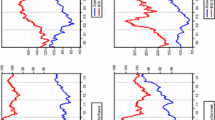Abstract
This study indicates that the effects of interest rate changes on stock prices could be twofold and that the net effect is determined by which effect is dominant. The study employs a threshold regression model to see if, before and after the central banks cut the interest rates, there is a nonlinear relation between interest rates and the stock index. Based on traditional economic theory, stock prices should be inversely related to interest rates. However, the present study finds that as interest rates start to increase or decrease, the stock index prices are significantly and positively related to the interest rates. The changes in interest rates affect stock indexes inversely only after interest rates have crossed a certain threshold. The inverse U-shaped relationship between interest rates and stock indexes differs from the traditional wisdom. It could make interest rates more valuable in forecasting stock indexes, and it holds implications for monetary policies of central banks. To avoid the spurious regression problem, this study uses a cointegration test and an error correction model to confirm the results from the threshold regression model and finds that there is a significant cointegration relationship before and after central banks cut interest rates.
Similar content being viewed by others
References
Abdullah D. A., Hayworth S. C. (1993) Macroeconometrics of stock price fluctuations. Quarterly Journal of Business and Economics 32: 50–68
Apergis N., Eleftheriou S. (2002) Interest rates, inflation, and stock prices: The case of the Athens stock exchange. Journal of Policy Modeling 24: 231–236
Asprem M. (1989) Stock prices, asset portfolios and macroeconomic variables in ten European countries. Journal of Banking and Finance 13: 589–612
Bernanke B. S., Kuttner K. N. (2005) What explains the stock market’s reaction to federal reserve policy?. Journal of Finance 60: 1221–1257
Bohl M. T., Siklos P. L., Werner T. (2007) Do central banks react to the stock market? The case of the bundesbank. Journal of Banking and Finance 31: 719–733
Booth J. R., Officer D. T. (1985) Expectations, interest rates, and commercial bank stocks. Journal of Financial Research 8: 51–58
Bredin D., Hyde S., Nitzsche D., O’Reilly G. (2009) European monetary policy Surprises: The response aggegate and sectoral stock market response. International Journal of Finance and Economics 14: 156–171
Davig T., Gerlach J. R. (2006) State-dependent stock market reactions to monetary policy. International Journal of Central Banking 2: 65–83
Dickey D. A., Fuller W. A. (1981) Likelihood ratio statistic for autoregressive time series with a unit root. Econometrics 49: 1057–1072
Domian D. L., Gilster J. E., Louton D. (1996) An expected inflation, interest rates, and stock returns. The Financial Review 31: 809–830
Elyasiani E., Mansur I. (1998) Sensitivity of the bank stock returns distribution to changes in the level and volatility of interest rate: A GARCH-M model. Journal of Banking and Finance 22: 535–563
Engle R. F., Granger C. W. J. (1987) Cointegration and error correction: Representation, estimation and testing. Econometrica 55: 251–276
Fama E. (1981) Stock returns, real activity, inflation and money. American Economic Review 71: 545–564
Flannery M. J., James C. M. (1984) The effect interest rate changes on the common stock returns of financial institutions. Journal of Finance 39: 1141–1153
Fleming M. J., Remolona E. M. (1997) What moves the bond market?. Economic Policy Review 3: 31–50
Granger C. W. J., Newbold P. (1974) Spurious regression in econometrics. Journal of Econometrics 2: 111–120
Hansen B. E. (1996) Inference when a nuisance parameter is not identified under the null hypothesis. Econometrica 64: 413–430
Hansen B. E. (1999) Threshold effects in non-dynamic panel: Estimation, testing and inference. Journal of Econometrics 93: 345–368
Hansen B. E. (2000) Sample splitting and threshold estimation. Econometrica 68: 575–603
Lee J. (1997) Money, income and dynamic lag patterns. Southern Economic Journal 64: 97–103
MacKinnon J. G. (1996) Numerical distribution functions for unit root and cointegration tests. Journal of Applied Econometrics 11: 601–618
Schwert G. W. (1989) Tests for unit roots: A Monte Carlo investigation. Journal of Business and Economic Statistics 7: 147–159
Shiller, R. J. (1988). Causes of changing in financial market volatility, pp. 1–22. The Federal Reserve Bank of Kansas City.
Titman S., Warga A. (1989) Stock returns as predictors of interest rates and inflation. Journal of Financial and Quantitative Analysis 24: 47–58
Tong H. (1978) On a threshold model. In: Chen C. H. (Ed.), Pattern recognition and signal processing. Sijthoff and Noordhoff, Amsterdam
Zordan, D. J. (2005). Stock prices, interest rates, investment survival. Econometrica USA, Illinois.
Author information
Authors and Affiliations
Corresponding author
Rights and permissions
About this article
Cite this article
Chen, GR., Wu, MH. How does Monetary Policy Influence Capital Markets? Using a Threshold Regression Model. Asia-Pac Financ Markets 20, 31–47 (2013). https://doi.org/10.1007/s10690-012-9157-9
Published:
Issue Date:
DOI: https://doi.org/10.1007/s10690-012-9157-9




